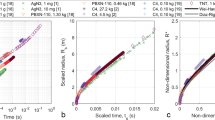Abstract
With density function theory BLYP/DNP method, together with homodesmotic reactions and isodesmic reactions, we calculated the resonance energies of some explosives, including eight nitro compounds which contains benzene rings, three nitro compounds which contains azaheterocycles (2,4-dinitroimidazole (2,4-DNI), 2,6-diamino-3,5-dinitropyrazine-1-oxide (LLM-105) and 2,4,6-trinitro-1,3,5-triazine) and one nitrogen-rich energetic compound of 3,3’-azobis(6-amino-s-tetrazine) (DAAT). The results indicate that their resonance energies are in relation to their shock sensitivity which measuring their threshold pressures of initiation, that is, the lower the resonance energy is, the higher the shock sensitivity of the explosive behaves. And this measuring method according to resonance energy is based on the global property of the molecule instead of the local one, such as one nitro group in the molecule. It is meaningful to calculate resonance energies of these kind of compounds quickly and accurately because resonance structures exist widely in these organic compounds and resonance energies may play a significant role in determining their shock sensitivity, and it is helpful in the rational design or synthesis of high energy and insensitive materials.
Similar content being viewed by others
References
Tokmakoff A, Fayer MD, Dlott DD (1993) Chemical reaction initiation and hot-spot formation in shocked energetic molecular materials. J Phys Chem 97:1901–1913
McNesby KL, Coffey CS (1997) Spectroscopic determination of impact sensitivities of explosives. J Phys Chem B 101:3097–3104
Tarver CM (1997) Multiple roles of highly vibrationally excited molecules in the reaction zones of detonation waves. J Phys Chem A 101:4845–4851
Wakabayashi K, Matsumura T, Nakayama Y, Yamada E, Koshi M (2007) Temporal change of raman spectra of carbon tetrachloride under laser-driven shock compression. AIP Conf Proc 955:1267–1270
Patterson JE, Dreger ZA, Miao M (2008) Shock wave induced decomposition of RDX. J Phys Chem A 112:7374–7382
McGrane SD, Moore DS, Funk DJ (2004) Shock induced reaction observed via ultrafast infrared absorption in poly(vinyl nitrate) films. J Phys Chem A 108:9342–9347
Dlott DD (2000) Nanoshocks in molecular materials. Acc Chem Res 33:37–45
Politzer P, Murray JS (1996) Relationships between dissociation energies and electrostatic potentials of C-NO2 bonds: applications to impact sensitivities. J Mol Struct 376:419–424
Rice BM, Sahu S, Owens FJ (2002) Density functional calculations of bond dissociation energies for NO2 scission in some nitroaromatic molecules. J Mol Struct THEOCHEM 583:69–72
Fried LE, Manaa MR, Pagoria PF, Simpson RL (2001) Design and synthesis of energetic materials. Annu Rev Mater Res 31:291–321
Rice BM, Hare JJ (2002) A quantum mechanical investigation of the relation between impact sensitivity and the charge distribution in energetic molecules. J Phys Chem A 106:1770–1783
Owens FJ (1996) Calculation of energy barriers for bond rupture in some energetic molecules. J Mol Struct THEOCHEM 370:11–16
Zeman S, Friedl Z, Rohac M (2006) Molecular structure aspects of initiation of some highly thermostable polynitro arenes. Thermochim Acta 451:105–114
Varga R, Zeman S (2006) Decomposition of some polynitro arenes initiated by heat and shock part I. 2,4,6-Trinitrotoluene. J Hazard Mater 132:165–170
Zhang C, Shu Y, Huang Y, Zhao X, Dong H (2005) Investigation of correlation between impact sensitivities and nitro group charges in nitro compounds. J Phys Chem B 109:8978–8982
Storm CB, Stine JR, Kramer JF (1990) In: Bulusu SN (ed) Chemistry and physics of energetic materials. Kluwer Academic Publishers, Dordrecht, pp 605–639
Delley B (1990) An all-electron numerical method for solving the local density functional for polyatomic molecules. J Chem Phys 92:508–517
Delley B (2000) From molecules to solids with the DMol3 approach. J Chem Phys 113:7756–7764
Material Studio 3.0 (2003) Acceryls Inc. San Diego
Becke AD (1988) A multicenter numerical integration scheme for polyatomic molecules. J Chem Phys 88:2547–2553
Lee C, Yang W, Parr RG (1988) Development of the Colle-Salvetti correlation-energy formula into a functional of the electron density. Phys Rev B 37:785–789
Wheeler SE, Houk KN, Schleyer PvR, Allen WD (2009) A hierarchy of homodesmotic reactions for thermochemistry. J Am Chem Soc 131:2547–2560
Bachrach SM (2002) Aromaticity of annulated benzene, pyridine and phosphabenzene. J Organomet Chem 643–644:39–46
Huang YZ, Yang SY, Li XY (2004) An investigation of the aromaticity of transition metal heterocyclic complexes by conventional criteria and indices of aromaticity. J Organomet 689:1050–1056
Nyulaszi L, Varnai P, Veszpremi T (1995) About the aromaticity of five-membered heterocycles. J Mol Struct THEOCHEM 358:55–61
Bird CW (1997) Heteroaromaticity. 10. The direct calculation of resonance energies of azines and azoles from molecular dimensions. Tetrahedron 53:13111–13118
Tan B, Long X, Peng R, Li H, Jin B, Chu S (2011) Insight into shock-induced chemical reaction from the perspective of ring strain and rotation of chemical bonds. J Comput Aided Mol Des, under review
Acknowledgments
This work is supported by “973” program of national defense of China (613830101–2).
Author information
Authors and Affiliations
Corresponding authors
Rights and permissions
About this article
Cite this article
Tan, B., Peng, R., Long, X. et al. An important factor in relation to shock-induced chemistry: resonance energy. J Mol Model 18, 583–589 (2012). https://doi.org/10.1007/s00894-011-1096-2
Received:
Accepted:
Published:
Issue Date:
DOI: https://doi.org/10.1007/s00894-011-1096-2




